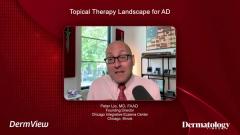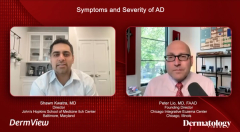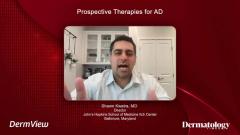
Prospective Therapies for AD
Experts discuss prospective therapies on the horizon for atopic dermatitis (AD).
Episodes in this series

Transcript
Shawn Kwatra, MD: Looking ahead in the management of atopic dermatitis, what are you most excited about?
Peter Lio, MD, FAAD: I’m very excited about some of the new topicals [that are] coming [out]. You mentioned them both, actually. Roflumilast topically is currently approved for psoriasis in the US, but [is] definitely in development for atopic dermatitis. It is super exciting. To me, it feels like a refinement or the next step [after a medication] like crisaborole. Again, the phosphodiesterase 4 pathway is gentle and safe; it seems like there probably will not be any black box warnings....It’s really accessible and only requires one daily application, which is kind of new. As you said, it is a very elegant formulation. I’m pretty interested in this cream, [although] it probably will not be for everybody. Then [there is] tapinarof, a totally different approach with a long history. I’ve been following that drug since 2016, [when I saw] the first poster [for] it, so I’ve been very excited. This aryl hydrocarbon receptor modulation seems to have some antioxidant effects [that] already [appear] to be pretty helpful in psoriasis, but may have not only itch relief, but also a remittive effect. I’m excited about that, too. [The question] is, is there something we can use for a while, [a] once-daily dosing cream, [for instance,] and then can we give patients a break? This is now going to enter into the discussion. We’re going to start talking about this with patients. When I talk about it, patients feel so excited...because [I’m not] saying, “Well, the only way we can [help you is that] you’ve got to keep using your medicine; good luck!” I love [having] the ability to say [to a patient], “Look, we can...break the cycle. We have to get you under control, and we must get you better. But then, yes, there is a really good chance that we’re going to be able to, at the very least, de-escalate some of this therapy and remove some of the [medications] that are unnecessary [and hopefully] get you to a point where you barely need anything or [perhaps you] can go back to a reactive [treatment regimen. Your symptoms are] mild enough now that...you [only] need to use this [medication] when [necessary].”
Shawn Kwatra, MD: Absolutely. You brought up some great points. One of the thoughts [you brought up] is remittive therapy, which is something that might be available [both] now and in the future,...one of the next-generation iterations. I’m also very excited about therapies that modulate the microbiome, either directly or indirectly. There have been some elegant studies conducted by Dr Gallo at the University of California, San Diego. We know more about the flares of atopic dermatitis and the [idea of] giving [patients] some of the good bacteria, the good microbiome species, even fungi....to me, that is exciting. The other thing that...is [being studied are patients] who have...more severe disease [and focusing on] differences in their gut microbiome. This is [a broad,] overarching view of dermatology. We know that atopic dermatitis rates are increasing, and we know that [issues] like hidradenitis suppurativa were not nearly this [much] of an issue before. I’ve always [wondered] about the roles [that] food, our gut, and processed foods [play in our bodies]. So, the microbiome and the quality of food that we’re eating are definitely linked. That must be something, Peter, that you get a lot of questions about [regarding] diet and over-the-counter supplements....[For example,] Ayurvedic medicine is focused on giving curcumin. Actually, when I’m sick, my parents give me curcumin or turmeric powder in milk. It is actually pretty good. You should try it, Peter; if you haven’t tried [it], it’s a good boost. Drop turmeric powder and a little bit of sugar in milk, warm it up, and...drink it. It seems to help with a lot of different [health problems]. I feel like there’s [a] nutraceutical movement going on. Any thoughts about that?
Peter Lio, MD, FAAD: That, my friend, is [a subject] for another meeting because we could go on all day! But, yes, I totally agree. There’s so much great stuff happening [in that area]. I’m very interested in the interface [between] conventional medicine, what we’re talking about so far today, and [more] integrative approaches. There are so many...Ayurvedic traditions that are incredibly rich, thousands of years of learning and testing things and wonderful ideas. There are so many traditions that we can learn from and borrow from. I truly believe that’s part of why conventional medicine is so powerful because we are willing to consider anything, even if we don’t know how things work. It took a long time for us to [understand the] mechanism of action for aspirin. Arguably, we still don’t know exactly how it works, right? We have ideas and we have a...dominant [hypothesis]. We can still take those [ideas], learn about them, and test them. To me, that’s super exciting. So, yes, absolutely. I’m a big fan of integrating different types of treatments, including mind and body [wellness practices]. That’s another important area. We’ve talked about this idea that stress can also damage the barrier and it can [cause] the whole [system] to be out of whack. If we can do things to cool the down our stress and to help [achieve better] sleep, [our bodies give us] positive feedback. Of course, the microbiome is one of the hottest topics right now; there’s so much excitement about the foods that we eat, and of course, we have probiotics, the live bacteria, but also prebiotics [and] their fuel, their food. Synbiotics are combinations of [both]. Post-biotics are the things that they make [and there are] parabiotics, dead bacteria [and so on]. There are so many ways to think about this [symbiosis] and we are just at the beginning [stage]. I had somebody ask me the other day: “So is anybody working on this?” [I replied] “Is anybody working on this?” [It’s more accurate to say:] “Is everybody working on this?” This is a whole new field; everyone’s going to have to put their heads together because the fundamental questions are still completely unanswered. [For example,] when people talk about probiotics...[they] don’t live in isolation. What [happens] when you mix them? It’s going to take combinatorial mathematics and [clinical] studies. We’re going to need to do a lot of work, so this is exciting. This is the next frontier, right? We are literally looking out[ward]. We’re at the space station looking out and saying, “My goodness the horizon seems to go on forever!” But I know that we’re going to make some headway because there’s a [collective] will, and we’re going to find ways to learn about this,...hopefully [during the span of] our careers.
Shawn Kwatra, MD: Thank you so much, Dr Lio. Thank you to all our audience [members] for watching this Dermatology Times DermView. If you enjoyed the content, please subscribe to our e-newsletters to receive upcoming programs and other great content right in your in-box.
Peter Lio, MD, FAAD: Thank you.
Transcript edited for clarity.
Newsletter
Like what you’re reading? Subscribe to Dermatology Times for weekly updates on therapies, innovations, and real-world practice tips.


























